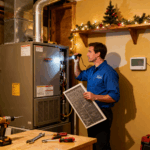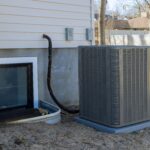
Is Your HVAC Ready for the Holidays? Maintenance Tips Before Guests Arrive
The holidays are a time for family, friends, and celebration but they can also put extra strain on your home’s
Your thermostat might be small, but it has a big impact on your comfort and energy bills throughout the year. Setting the right temperature for each season helps you stay cozy while keeping your HVAC system running efficiently. Whether you’re battling summer heat or winter chills, knowing the ideal thermostat settings can save you money and help extend the life of your heating and cooling system.
Let’s take a look at the best thermostat settings for every season and a few tips to make them work even better.
Spring weather can be unpredictable, warm one day, chilly the next. During this transitional season, your thermostat should keep you comfortable without running constantly.
For most homes, setting your thermostat to around 68°F during the day works well when you’re home. At night or when you’re away, you can lower it to around 64–66°F. On mild days, you might even be able to turn your HVAC system off and open your windows for some natural ventilation.
Tip: If your HVAC system has a fan-only mode, use it to circulate fresh air throughout your home on days when it’s not too hot or cold.
When the summer heat hits, it’s tempting to crank the air conditioning as low as it will go but doing so can quickly drive up your energy bills. The U.S. Department of Energy recommends keeping your thermostat set to 78°F when you’re home during the summer.
If you’ll be away from home for several hours, increase the setting to around 82–85°F. This prevents your AC from running unnecessarily while still keeping humidity levels manageable.
Tip: Use a programmable or smart thermostat to automatically adjust temperatures when you’re home, asleep, or away. Smart thermostats can even learn your habits over time and fine-tune the temperature for comfort and efficiency.
As temperatures start to drop in the fall, it’s time to switch from cooling to heating. The ideal thermostat setting for autumn days is around 68°F while you’re home and awake. At night or when you’re away, lower it to 60–62°F to save energy.
This slight drop in temperature not only reduces your utility bills but also helps your body adjust naturally to the cooler season. If your home feels drafty, check your windows and doors for air leaks—proper insulation helps your HVAC system work more efficiently.
Tip: Before you switch to heating full-time, schedule an HVAC maintenance check to make sure your furnace or heat pump is ready for the season ahead.
During the coldest months of the year, the ideal thermostat setting is around 68°F when you’re at home. Lowering it to 60–62°F while you’re asleep or away can lead to significant savings on your heating bill.
Every degree you lower your thermostat in the winter can reduce your energy use by up to 1–2%, so even small adjustments make a difference. Using warm bedding and layering clothes indoors allows you to stay comfortable while keeping your thermostat lower.
Tip: For even greater comfort, consider investing in a zoned heating system, which lets you control the temperature in different areas of your home separately.
The ideal thermostat setting isn’t just about comfort it’s also about efficiency. By making small adjustments throughout the year and using your thermostat wisely, you can stay comfortable in every season while saving on energy costs.

The holidays are a time for family, friends, and celebration but they can also put extra strain on your home’s

Getting a good night’s sleep is essential for your health, mood, and productivity. But did you know your HVAC system

When temperatures hit record highs in the summer or plunge well below freezing in the winter, you expect your HVAC